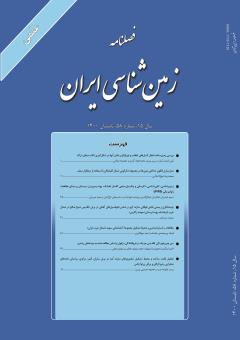سن چینخوردگی تاقدیس جریک در فروافتادگی دزفول براساس مطالعه هندسه چینههای رشدی
محورهای موضوعی :احمد لشگری 1 , محمود رضا هیهات 2 , محمد مهدی خطیب 3 , مهدی نجفی 4
1 - دانشگاه بیرجند
2 - دانشگاه بیرجند
3 - دانشگاه بیرجند
4 - دانشگاه تحصیلات تکمیلی علوم پایه زنجان
کلید واژه: فروافتادگي دزفول# تاقديس جریک# سازند آغاجاری# چینههای رشدی#,
چکیده مقاله :
نحوه توسعه زمانی و مکانی دگرریختی در کمربندهای چینخورده - رانده یکی از جنبههای مهم درک تکامل ساختاری این پهنههای دگرریخت شده است. با تعیین سن دگرریختی در یک ناحیه و مقایسه آن با نواحی مختلف یک کمربند چینخورده – رانده میتوان به درک بهتری از تاریخچه تکامل ساختاری آن دست یافت. زمان شروع و نحوه توسعه دگرشکلی (کوهزایی) در کمربند چینخورده -رانده زاگرس از موضوعاتی است که بهطور گستردهای بررسی شده و باور عمومی بر آن است که کوهزایی در زاگرس از میوسن با برخورد دو ورقه ایران مرکزی و عربستان شروع و از شمال شرق به جنوب غرب بهتدریج توسعهیافته است. در این پژوهش، سن چینخوردگی بر اساس مطالعه هندسه نهشته چینههای رشدی، اواخر میوسن میانی (سراوالین) برآورد شده است. نتایج این مطالعه نشان میدهد که زمان آغاز چینخوردگی تاقدیس جریک در این ناحیه همزمان با نهشته شدن آغاجاری زیرین است.
Determining the direction of deformation migration in the fold- thrust belts, is one of the basic aspects for understanding the structural evolution of the fold and thrust belts. By studying the timing and mechanism of deformation and compare it with different regions of a fold thrust belt, it is possible to gain a better understanding the history of the structural evolution. The timing and development of deformation in the Zagros folded belt is one of the widely studied topics and the general belief is that collision of two plates of central Iran and Arabian began in Miocene, and gradually developed from the northeast to the southwest. According to the present study, the timing of folding of the Jaril anticline in the northern of Dezful embayment is estimated to be end of Middle miocene (Serravalian). The results of the present study indicated that the onset folding of the Jarik anticline in this area coincides with the deposition of the lower Aghajari Formation.
Berberian, M., 1995. Master Blind thrust faults hidden under the Zagros folds: active basement tectonics and surface morphotectonics. Tectonophysics, 241, 193-224.
- Burbank, D.W., Puigdefa' bregas, C. and Mun_ oz, J.A., 1992. The chronology of eocene tectonic and stratigraphic development of the Eastern Pyrenean Foreland Basin, Northeast Spain. Geological Society of America Bulletin, 104, 1101-1120.
- Burbank, D.W. and Reynolds, R.G.H., 1988. Stratigraphic keys to the timing of thrusting inTerrestrialForelandBasins: applications of the Northwestern Himilaya. In: New Perspectives in Basin Analysis (Ed. by K.L. Kleinspehn and C. Paola),. Springer-Verlag, NewYork, 331-351.
- Burbank, D.W. and Verge´s, J., 1994. Reconstruction of topography and related depositional systems during active thrusting. Journal of Geophysical Research 99, 20281- 20297.
- Casas-Sainz, A.M., Soto-Marı´n. R., Gonza´lez. A. and Juan Jose´ Villalaı´n .J.J., 2005. Folded onlap geometries: implications for recognition of syn-sedimentary folds. Journal of Structural Geology 27, 1644-1657.
- Derikvand, B., Alavi, A., Abdollahie Fard, I. and Haji Ali Beigi, H., 2018. Folding style of the Zagros foreland and foredeep: signatures of detaching horizons, deep-rooted faulting and syn-deformation deposition. Marine and Petroleum Geology, 91, 501-518.
- Emami, H., 2008. Foreland propagation of folding and structure of the Mountain Front Flexure in the Pusht-e Kuh arc (NW Zagros, Iran), PhD thesis, University de Barcelona, Barcelona, 118.
- Homke, S., Verges, J., Garces, M., Emami, H. and Karpuz, R., 2004. Magnetostratigraphy of Miocene-Pliocene Zagros foreland deposits in the front of the Push-e Kush Arc (Lurestan Province, Iran), Earth and Planetary Science Letters., 225(3–4), 397–410.
- Jordan, T.E. and Alonso, R.N., 1987. Cenozoic stratigraphy and BasinTectonics of the AndesMountains, 20-281 South Latitude. American Association of Petroleum Geologists Bulletin, 71, 49-64.
- Khadivi, S., Mouthereau, F., Larrasoana, J. C., Verges, J., Lacombe, O., Khademi, E., Beamud, E., Melinte- Dobrinescu, M. and Suc, J. P., 2010. Magnetochronology of synorogenic Miocene foreland sediments in the Fars arc of the Zagros Folded Belt (SW Iran), Basin Research, 22,6, 918–932.
- Najafi, M., Beamud, E., Ruh, J., Mouthereau, F., Tahmasbi, A Bernaola, G., Yassaghi, A., Motamedi, H., Sherkati, S., Hassan Goodarzi, M.G. and Vergés, J., 2020. Pliocene growth of the Dowlatabad syncline in Frontal Fars arc: Folding propagation across the Zagros Fold Belt, Iran: Geological Society of America Bulletin (2020).
- Pirouz, M., Simpson. G, Chiaradia, M., 2015. Constraint on foreland basinmigration in the Zagros mountain belt using Sr isotope stratigraphy, Basin Research., 27,6, 714–728.
- Reynolds, J. H., Jordan, T. E., Johnson, N. M., Damanti, J. F. and Tabbutt, K. D., 1990. Neogene deformation of the Flat-Subduction Segment of the Argentine-Chilean Andes: magnetostratigraphic constraints from Las Juntas, La Rioja Province, Argentina. Geological Society of America Bulletin, 102, 1607-1622.
- Ruh, J.B., Hirt, A.M., Burg, J.P. and Mohammadi, A., 2014. Forward propagation of the Zagros Simply Folded Belt constrained from magnetostratigraphy of growth strata. Tectonics, 33, 1534-1551
- Schlunegger, F., Matter, A., Burbank, D.W. and Klaper, E.M., 1997. Magnetostratigraphic constraints on relationships between evolution of the Central Swiss Molasse Basin and Alpine Orogenic events. Geological Society of America Bulletin, 109, 225-241
Shaw, J. H., S. C. Hook, and Satrio, B., 1997, Complex structural reactivation defined by growth strata: American Association of Petroleum Geologists Annual Meeting Abstracts, 6, 106.
- Vergés, J., Marzo, M., and Mun˜oz, J.A., 2002. Growth strata in foreland settings. Sedimentary Geology, 146, 1–10.


